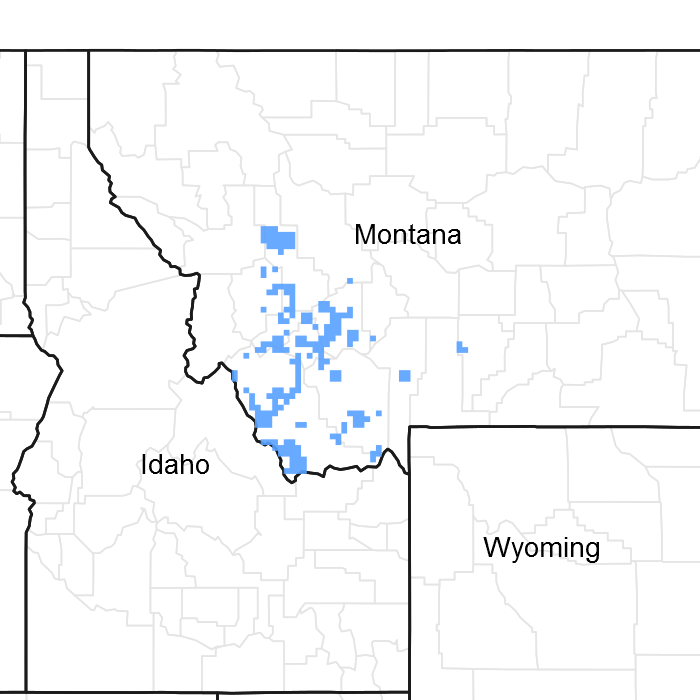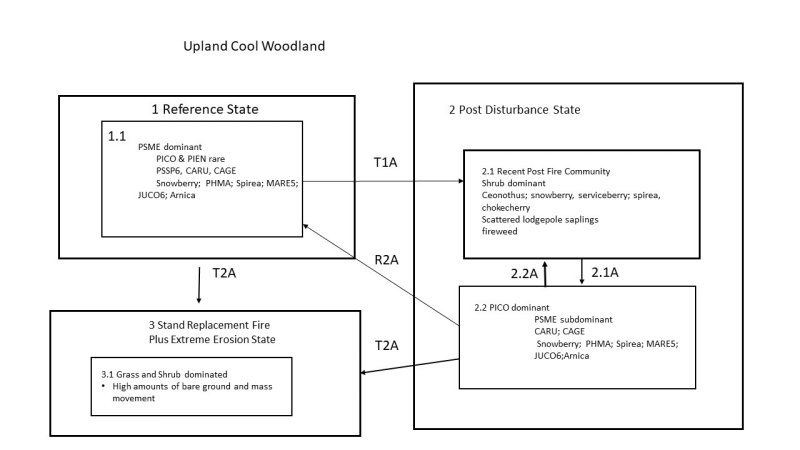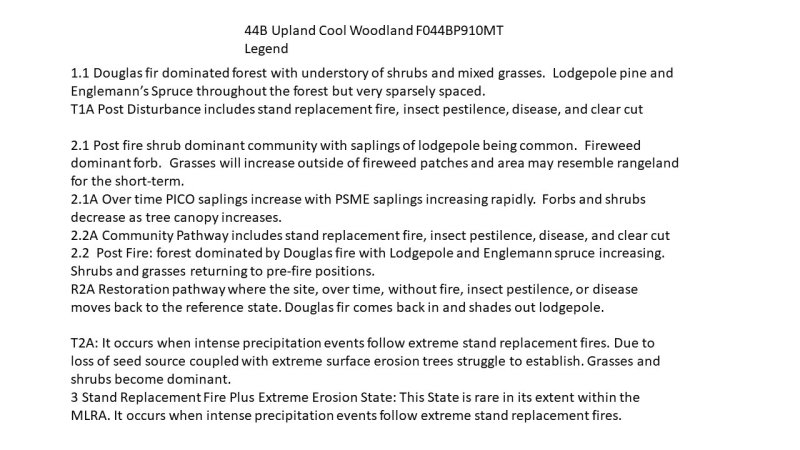
Natural Resources
Conservation Service
Ecological site F044BP910MT
Upland Cool Woodland
Last updated: 9/07/2023
Accessed: 12/18/2025
General information
Provisional. A provisional ecological site description has undergone quality control and quality assurance review. It contains a working state and transition model and enough information to identify the ecological site.

Figure 1. Mapped extent
Areas shown in blue indicate the maximum mapped extent of this ecological site. Other ecological sites likely occur within the highlighted areas. It is also possible for this ecological site to occur outside of highlighted areas if detailed soil survey has not been completed or recently updated.
MLRA notes
Major Land Resource Area (MLRA): 044B–Central Rocky Mountain Valleys
This MLRA is nearly 3.7 million acres of Southwest Montana and borders two MLRAs, 43B Central Rocky Mountains and Foothills and MLRA 46X Northern and Central Rocky Mountain Foothills.
The major watersheds of this MLRA are those of the Missouri and Yellowstone Rivers along with their associated headwaters such as the Beaverhead, Big Hole, Jefferson, Ruby, Madison, Gallatin, and Shields Rivers. These waters allow for extensive irrigation for crop production in an area that would generally be only compatible with rangeland and grazing. The Missouri River and its headwaters are contained behind several reservoirs used for irrigation water, hydroelectric power, and municipal water. Limited portions of the MLRA are west of the Continental Divide along the Clark Fork River.
The primary land use of this MLRA is production agriculture (grazing, small grain production, and hay), but there is some limited mining. Urban development is also extensive.
MRLA 44B consists of one Land Resource Unit (LRU) and seven climate-based LRU subsets. Annual precipitation ranges from a low of 9 inches to a high near 24 inches. The driest areas tend to be in the valley bottoms of southwest Montana in the rain shadow of the mountains. The wettest areas tend to be near the edges of the MLRA where it borders with MLRA 43B. Frost-free periods also vary greatly with from less than 30 days in the Big Hole Valley to approximately 110 days in the warm valleys along the Yellowstone River and Missouri River Headwaters.
The plant communities of the MLRA 44B are highly variable, but cool-season grass and shrub steppe communities on rangeland and a mixed coniferous forest in the mountains are dominant. Warm-season grasses occupy an extremely limited extent in this MLRA. Most subspecies of big sagebrush are present to some extent across the MLRA.
LRU notes
LRU 01 Subset A:
- Soil Moisture Regime: Ustic, dry (bordering Aridic)
- Soil Temperature REgime: Frigid
- Dominant Cover: Rangeland (mixed grassland and sagebrush steppe)
- Representative Value (RV) range of Effective Precipitation: 9-14 inches (228 - 355 mm)
- Representative Value (RV) range of Frost-free Days: 70-110 days
Classification relationships
EPA Ecoregions of Montana, Second Edition:
Level I: Northwestern Forested Mountains Level II: Western Cordillera
Level III: Middle Rockies & Northern Great Plains Level IV: Paradise Valley
Townsend Basin
National Hierarchical Framework of Ecological Units:
Domain: Dry
Division: M330 – Temperate Steppe Division – Mountain Provinces
Province: M332 –Middle Rocky Mountain Steppe – Coniferous Forest – Alpine Meadow Section: M332D – Belt Mountains Section
M332E – Beaverhead Mountains Section
Subsection: M332Ej – Southwest Montana Intermontane Basins and Valleys
M332Dk – Central Montana Broad Valleys
Ecological site concept
• Site does not receive any additional water
• Dominant Cover: Coniferous Forest
• Soils are
o Generally not saline or saline-sodic (limited extent)
o Moderately deep, deep, or very deep
o Typically less than 5% stone and boulder cover (<15% max)
• Soil surface texture ranges from sandy loam to clay loam in surface mineral 4”
• Parent material is tertiary valley fill and recent alluvium
• An area of dissected mountain valleys. The valleys are typically bordered by mountains trending north to south.
• Site landform: hillslope, escarpments, fan remnants
• Moisture Regime: ustic
• Temperature Regime: cryic
• Elevation Range: 3800-6850
• Slope: 0-60% (typically less than 25%)
Associated sites
| F044BP903MT |
Shallow Cool Woodland Shallow Cool Woodland is adjacent to this site often higher on the landscape |
|---|
Similar sites
| F044BP903MT |
Shallow Cool Woodland Shallow Cool Woodland expresses a similarly structured forest lower production in the kinds and amounts of species. |
|---|
Table 1. Dominant plant species
| Tree |
(1) Pseudotsuga menziesii |
|---|---|
| Shrub |
(1) Symphoricarpos albus |
| Herbaceous |
(1) Pseudoroegneria spicata |
Click on box and path labels to scroll to the respective text.

